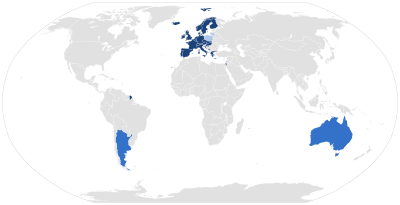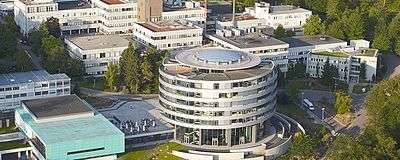European Molecular Biology Laboratory
 | |
| Established | 1974 |
|---|---|
| Director General | Iain Mattaj[1] |
| Faculty | ~95 |
| Location |
|
| Website |
www |
The European Molecular Biology Laboratory (EMBL) is a molecular biology research institution supported by 25 member states, four prospect and two associate member states.[2] EMBL was created in 1974 and is an intergovernmental organisation funded by public research money from its member states. Research at EMBL is conducted by approximately 85 independent groups covering the spectrum of molecular biology. The Laboratory operates from six sites: the main laboratory in Heidelberg, and outstations in Hinxton (the European Bioinformatics Institute (EBI), in England), Grenoble (France), Hamburg (Germany), Monterotondo (near Rome) and Barcelona (Spain). EMBL groups and laboratories perform basic research in molecular biology and molecular medicine as well as training for scientists, students and visitors. The organization aids in the development of services, new instruments and methods, and technology in its member states.
History
EMBL was the idea of Leó Szilárd,[3] James Watson and John Kendrew.[4] Their goal was to create an international research centre, similar to CERN, to rival the strongly American-dominated field of molecular biology.[5] Kendrew served as the first Director-general of EMBL until 1982, and was succeeded by Lennart Philipson.[6][7][8] From 1993 to 2005 Fotis Kafatos,[9][10] served as director and was succeeded by Iain Mattaj, EMBL's fourth and current Director General since 2005.[1] In January 2019, Edith Heard will succeed Mattaj, becoming the fifth Director General of EMBL and the first woman to hold this position.[11]
Research

Each of the different EMBL sites have a specific research field. The EMBL-EBI is a hub for bioinformatics research and services, developing and maintaining a large number of scientific databases, which are free of charge. At Grenoble and Hamburg, research is focused on structural biology. EMBL's dedicated Mouse Biology Unit is located in Monterotondo. Scientists at EMBL Barcelona will explore how tissues and organs function and develop, in health and disease [12]. At the headquarters in Heidelberg, there are units in Cell Biology and Biophysics, Developmental Biology, Genome Biology and Structural and Computational Biology as well as service groups complementing the aforementioned research fields.
Many scientific breakthroughs have been made at EMBL, most notably the first systematic genetic analysis of embryonic development in the fruit fly by Christiane Nüsslein-Volhard and Eric Wieschaus,[13] for which they were awarded the Nobel Prize in Physiology or Medicine in 1995.
Membership

| Member country[2] | Year of joining |
|---|---|
| 1974 | |
| 1990 | |
| 2006 | |
| 2014 | |
| 1974 | |
| 1984 | |
| 1974 | |
| 1974 | |
| 1984 | |
| 2017 | |
| 2005 | |
| 2003 | |
| 1974 | |
| 1974 | |
| 2007 | |
| 2016 | |
| 2018 | |
| 1974 | |
| 1985 | |
| 1998 | |
| 2018 | |
| 1986 | |
| 1974 | |
| 1974 | |
| 1974 | |
| Prospect Member State | |
| 2015[14] | |
| 2014[15] | |
| Associate member | |
| 2014[16] | |
| 2008 | |
Training

Advanced training is one of EMBL's five core missions.[17] Over the years, the Laboratory has established a number of training activities, of which the EMBL International PhD Programme (EIPP) is the flagship - it has a student body of about 200, and since 1997 has had the right to award its own degree. Other activities include the postdoctoral programme, including the EMBL Interdisciplinary Postdoctoral programme (EIPOD); the European Learning Laboratory for the Life Sciences (ELLS) for teacher training; and the Visitor Programme.[18] EMBL is currently building a centre for high-resolution light and electron microscopy in its Heidelberg Headquarters. This centre will be open to visiting scientists worldwide and provide a unique service facility for the life sciences, uniting cutting-edge equipment, experts and data analysis.[19]
EMBL Advanced Training Centre
In March 2010, the EMBL Advanced Training Centre (ATC) was inaugurated on the main campus in Heidelberg. Shaped in the form of a double helix,[20] it hosts conferences and provides training.
Science and society
EMBL also runs an active Science and Society Programme which offers activities and events on current questions in life science research for the general public and the scientific community.[21]
See also
Notes and references
- 1 2 MATTAJ, Iain William. ukwhoswho.com. Who's Who. 2015 (online Oxford University Press ed.). A & C Black, an imprint of Bloomsbury Publishing plc.

- 1 2 "EMBL member states". European Molecular Biology Laboratory. 2015.
- ↑ Maas, W; Crow, J. F. (2004). "Leo Szilard: A personal remembrance". Genetics. 167 (2): 555–8. doi:10.1534/genetics.104.030320. PMC 1470899. PMID 15238510.
- ↑ Holmes, K. C. (2001). "John Cowdery Kendrew". Biographical Memoirs of Fellows of the Royal Society. 47: 311–332. doi:10.1098/rsbm.2001.0018. PMID 15124647.
- ↑ "EMBL History". 2015. Archived from the original on 2014-04-13.
- ↑ Pettersson, U (2011). "Lennart Philipson: A fighter is gone". Proceedings of the National Academy of Sciences. 108 (47): 18875. doi:10.1073/pnas.1116859108. PMC 3223467. PMID 22106290.
- ↑ Simons, K.; Mattaj, I. W. (2011). "Lennart Philipson (1929-2011)". Science. 333 (6043): 711. doi:10.1126/science.1210990. PMID 21817041.
- ↑ Baltimore, D. (2011). "Lennart Philipson (1929–2011): A Warrior Has Passed". PLoS Biology. 9 (9): e1001153. doi:10.1371/journal.pbio.1001153.
- ↑ Gilbert, N. (2010). "The labours of Fotis Kafatos". Nature. 464 (7285): 20. doi:10.1038/464020a. PMID 20203577.
- ↑ Kafatos, F. (2008). "Straight talk with...Fotis Kafatos". Nature Medicine. 14 (9): 902–903. doi:10.1038/nm0908-902. PMID 18776875.
- ↑ Noyes, Dan (2017-06-28). "EMBL Council selects next Director General". EMBL etc.
- ↑ https://www.embl.es/aboutus/general_information/about-embl-barcelona/index.html
- ↑ Nüsslein-Volhard, C.; Wieschaus, E. (1980). "Mutations affecting segment number and polarity in Drosophila". Nature. 287 (5785): 795–801. doi:10.1038/287795a0. PMID 6776413.
- ↑ "Lithuania, new prospect member state".
- ↑ "Witamy! EMBL welcomes Poland as prospect member state".
- ↑ "Argentina joins EMBL as associate member state".
- ↑ https://www.embl.de/aboutus/general_information/mission/
- ↑ Training at EMBL, EMBL website
- ↑ https://news.embl.de/lab-matters/funding-agreed-imaging-technology-centre/
- ↑ University of Heidelberg Press Releases
- ↑ Science and Society Programme, EMBL website
External links
Coordinates: 49°23′4.64″N 8°42′36.51″E / 49.3846222°N 8.7101417°E